Jump in and learn with us how to make scented candles. Explore how to use your favorite essential oils like Rose Geranium, Lavender, and Bergamot to make your candles at home. Use fragrance oils like 1001 - My Way, Coco Chanel #5, Ocean Rain, and no one would ever guess it was a DIY candle. Honeysuckle and Jasmine is the perfect fragrance to learn how to layer its scent profile. You may just want to make homemade candles in mason jars at home or learn how to make scented candles to sell, come and join us on this fragrant journey. Make Relaxing, Sensuous, and Uplifting scented candles with just essential oils. Use just fragrance oils to make Sophisticated, Refreshing, or Comforting scented candles. Combine both in recipes for Sex Bomb, Welcome Home, and Wow Me Scented Candle blends. Explore perfume dupes and make candles inspired by Chanel, Gaultier, and Armani.
When people first start to learn how to make scented candles they want to learn specific things like:
- how to make scented candles without essential oils
- how to make scented candles with essential oils
- how to make scented candles in a jar
- how to make scented candles with perfume
- how to make scented candles to sell
We will cover all of this and so much more in this exciting new article.
Why Learn How to Make Scented Candles Now?
It is the perfect time to learn how to make scented candles. It is that time of year to bring in the light! It is also the time of year when people buy the most candles.
We have three events coming up over the next month that all use candles in some way, either in joyous celebration or solemn remembrance. Candles are used for so many reasons in our lives from the happiest moments to the saddest.
Let’s start with one of the happiest…
Diwali on November the 12th 2023
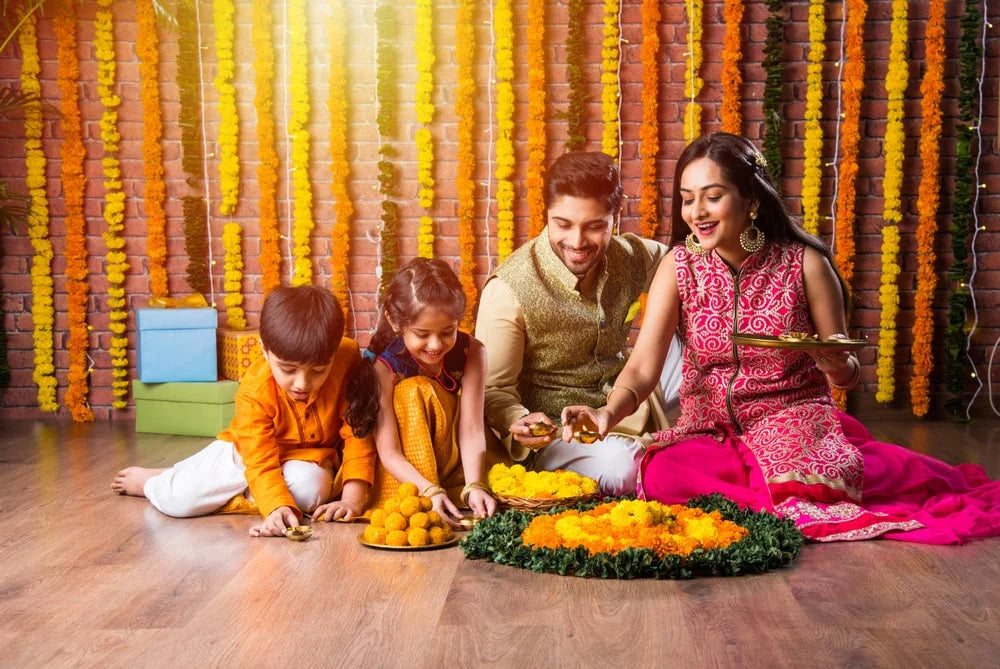
Kicking things off we have Diwali also known as the Festival of Lights. I always love driving by the local temples and seeing them all decked out in beautiful lamps and candles and everyone wearing their finest and fanciest clothes. It’s a sight to behold as one of India's biggest and most important holidays of the year.
Diwali (also called Dipawali) derived its name from the decorative rows (avali) of simple clay lamps (deepa) that are lit up outside of homes across India. You can see the clear origins of the name Deepa-avali.
The lamps are lit to symbolize the inner light inside us that is there to protect us from spiritual or energetic darkness.
It is comparative in importance to Hindus, as Christmas is to the Christians. However, it is also celebrated across the world by Jains, Sikhs, and Indian Buddhists.
Diwali Is Traditionally Celebrated Over Five days
| Day One | On the first day, homes are thoroughly cleaned and it is traditional to go shopping for gold to bring prosperity and luck or just simple kitchen utensils to bring good fortune and blessings into the home. |
|---|---|
| Day Two | On the second day, homes are beautifully decorated with glowing clay lamps and candles. They also create intricate and beautiful design patterns called Rangoli. They are created using colored powders or sand and are usually found on the floor |
| Day Three | On the third day, it is the main day of the festival. All over the world Indian families will congregate and gather together for a reverent Lakshmi puja. This is a special prayer to the Goddess Lakshmi. After the special puja, there are big celebrations with mouth-watering and abundant feasts of food and it is usually rounded off with fireworks or releasing lanterns. The river Ganges creates a stunning place to worship at this time. |
| Day Four | The fourth day is essentially the first day of the New Year. Like many New Year celebrations, friends and relatives visit one another and bring gifts. It is a time to share blessings, goodwill, and wishes for the season and year ahead. |
| Day Five | The fifth day may seem unusual, but it is when the brothers of the family visit their married sisters. The sisters will welcome their brothers with love and a celebratory and joyous meal. |
Veterans Day on November 11th

Veterans Day was originally known as Armistice Day up until 1954. It is intended to honor those who have served in the Armed Forces.
It falls on November 11th every year and coincides with Remembrance Day in the UK and other countries around the world. The date was chosen as it marks the anniversary of the end of World War I.
It is also observed at the time that the hostilities officially ended on the 11th hour of the 11th day of the 11th month of 1918. It has been observed every year since despite its name changes.
It is time across the world where candles are lit both publicly and privately to remember veterans who served and gave their lives in the name of their countries.
Worldwide Candle Lighting Day on December 12th
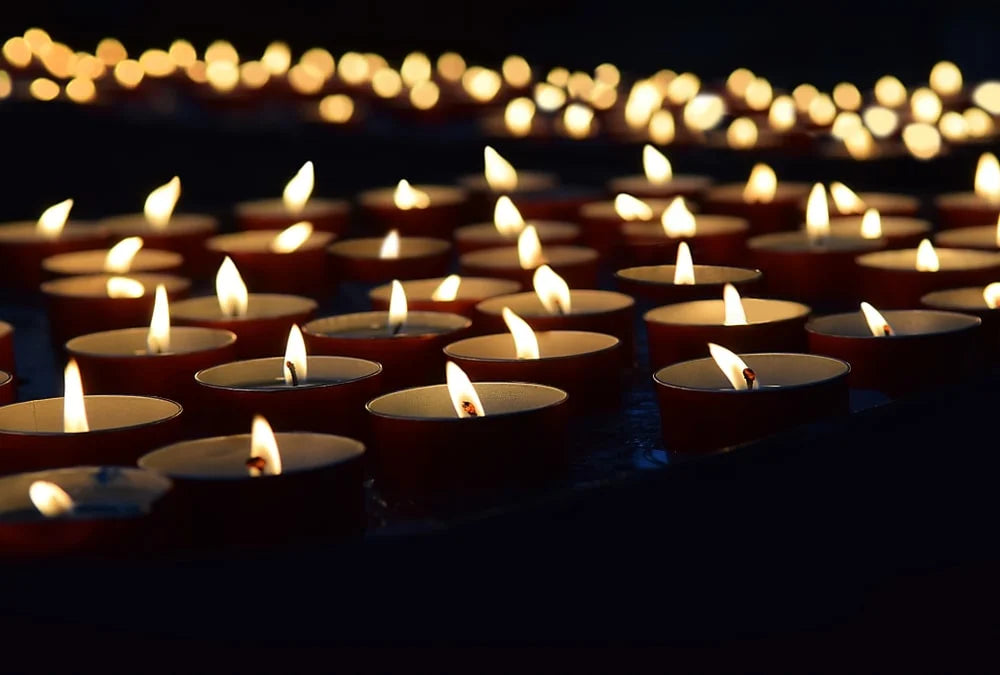
We often light candles in remembrance and reverence, to send prayers, blessings, or petitions.
Since time immemorial the action of lighting a candle has been a way to show respect, either when asking for a prayer to be answered or to remember those that have passed from our world.
When we light candles in remembrance it demonstrates that while a person may be gone from our world, their memory continues to endure. A symbol of being honored, remembered, and even revered.
It can also symbolize hope for the future. That the light of their inner flame, the flame representing their soul, will continue to endure, inspiring us, moving us and even guiding us.
Worldwide Candle Lighting Day is an act of true solidarity, reverence, and memory. People across the globe light candles for those who have passed. Showing that they will always be loved and never forgotten.
Ideally, the candles are all lit at the same time, in every time zone and every country.
What Are The Benefits Of Making Your Scented Candles?
Luxe and Unique
By learning how to make scented candles you can stop relying on those expensive brands churning out generic candles and slapping a price tag on to match the name.
We often think, because we are paying a lot of money, that we are getting the best ingredients that money can buy. That is not always the case, unfortunately.
By making candles yourself, you can get the best ingredients that your budget will allow. Even working on the tightest of budgets you can still make something that looks and feels both decant and luxurious.
We often experience ‘Imposter Syndrome’ when we do homemade. In some ways, we think it is inferior because we made it. Generally, the opposite is true. It has been made to exacting standards with quality ingredients and often surpasses what can be bought commercially.
You buy handmade candles from the artisan seller in the farmers market, how are yours any different from theirs?
Control
One of the best things when learning how to make scented candles is you get complete, utter control.
You can be picky and choosy over every single ingredient that goes into them. There is a lot to be said for knowing what is in them. It allows us to make healthier choices, choosing ingredients with less chemicals or toxicity.
If you have a family at home with respiratory needs, this can be a key point. It allows you to choose ingredients that suit every member of the household. Needless to say, this can be a rather useful sales point to capitalize upon if you plan to sell your candles.
Cost
I learned how to make scented candles because I could not afford the candles that I wanted. They were simply out of my budget. The ones I love, still are, unless I get them from TJMaxx on reduction.
At first, I was very surprised at how far my ingredients went and how many candles I could make. Not only that but what good quality they were.
Of course, you can choose your price points to suit your budget. It will also depend if you are making a handful for yourself or planning to make a lot to sell them on.
Branded candles can be very expensive, but making your scented candles can be extremely cost-effective and they make affordable gifts for the holiday season. Who doesn’t love a scented candle right?
Sustainability
Part of the joy of learning how to make scented candles is in the control of the process. You have complete design control. It also means you can make eco-conscious choices and create a sustainable future.
You have control over making sustainable choices in terms of the ingredients, do you go organic for instance?
Your packaging is key. Do you use a candle glass that will need to be recycled or create a pillar candle where the only waste is the wick holder, and generally they can be recycled easily? Do you plastic wrap it or create a protective paper sleeve? Do you box it, or not? YOU are in charge of all of these decisions and you can do your bit for the planet.
If you plan to sell your candles, your eco-conscious choices and design principles make up part of your sales points. I’d buy a scented candle in just a paper sleeve if the design and presentation were spot on. Would you?
Hobby Business
People all over are learning how to make scented candles to set up a hobby business. And business is booming!
We get inquiries all the time from people looking to start their own candle-making business and we love to support you and help you make the best possible choices for your business.
If you enjoy making candles, why not look into setting up a hobby business and let it grow at a rate that suits you? Maybe, you need to fit it around the kids, another job, and family responsibilities. It could be the perfect choice for you.
How To Make Scented Candles- What Do I Need?
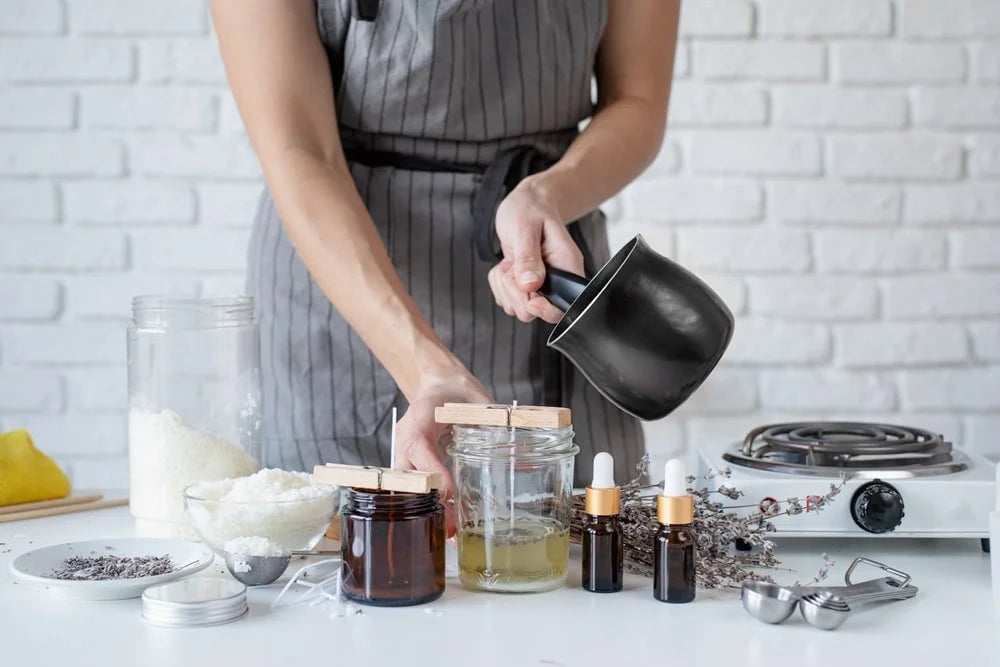
The good thing about learning how to make scented candles is that you don’t need a whole truck full of stuff to do it.
Whether you are learning how to make scented candles to sell, or how to make scented candles in a jar. You don’t need a great deal of kit.
Wax
Naturally wax is a prerequisite when learning how to make scented candles.
There are plenty of choices and different types of wax but for this article, we will focus on just three. You can generally buy it as a solid block, beaded/pelleted or flaked.
Soy Wax
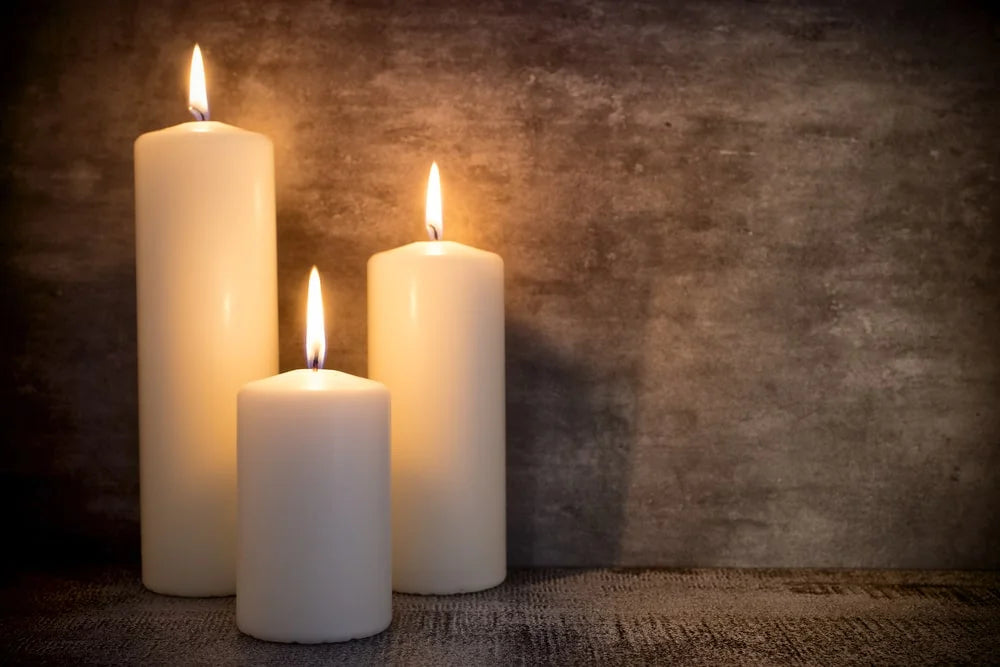
Soy wax flakes are derived from a natural source. However, you do need to be cautious because sometimes it can come from sources where it has been sprayed with toxic chemicals and pesticides. You cannot always guarantee looking at the descriptions online that it is not GMO soy. Do your homework if this is important to you.
Many candle makers choose soy as their preferred wax base for making scented candles. Soy is well known and widely utilized for producing an even and consistent release of fragrance, generally, for the entire burn time.
Soy tends towards clean burning and it is widely reported that it is easy to combine with wax dyes.
It has a wonderfully creamy color and the smooth texture is highly appealing. This is generally why it is the choice for people purveying that luxury aesthetic.
It is a good natural vegan alternative for those who don’t like to buy or use beeswax
Paraffin Wax

Paraffin wax is a mineral-derived wax, which is why it is often eschewed these days.
However, it is widely used because of its ability to ‘throw’ a strong scent into a room and for that to have some longevity across the life of the candle. It has a fairly consistent ability to do this as well. Making it the perfect choice for people who like strongly scented candles and want to smell them for hours.
Not only that, it reacts predictably and takes both color and fragrance readily. This alone makes it a good choice for someone learning how to make scented candles
It also tends to be an affordable choice making it a good place to start as you would be less worried about making mistakes.
Beeswax
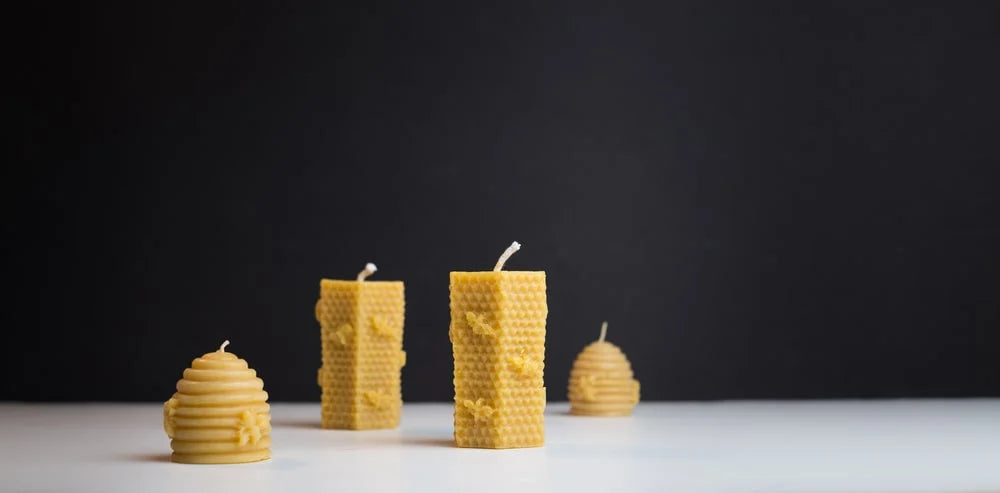
Beeswax helps to make candles that are healthy, sustainable, and wonderfully eco-conscious. The beeswax itself comes from a natural and renewable source. Helping to make it one of the greenest and most eco-friendly candles that you can burn.
If the natural honeyed fragrance wasn’t reason enough, beeswax is jam-packed with incredible health benefits. It is naturally non-toxic (you could eat it, but we urge you not to). It has antimicrobial, antibacterial, and antifungal properties and that is even before you have added any essential oils!
I like beeswax because it always burns clean and pure; it is mostly soot-free. Another absolute boon is that as your beeswax candles burn they emit negative ions into the air as well! What more could you ask for? Oh, I know… a longer-lasting wax, here you have it!
Personally, for creating a luxury and eco-conscious aromatherapy candle, beeswax would always be my wax of choice.
Molds or Glasses
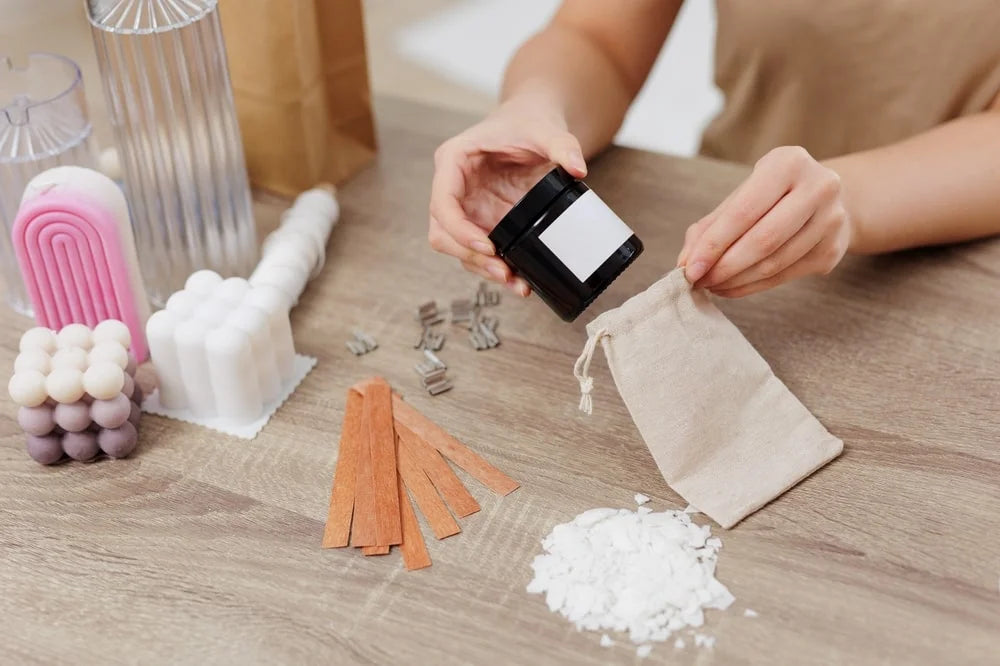
So you’re learning how to make scented candles and you have your wax, what else do you need?
When making homemade candles what to put them in can often be the issue. You will need either some molds or some candle glasses. Plenty of people making DIY candles will just pop them into mason jars for using the candles at home, which is great because mason jars are generally heatproof.
Candle glasses need to be heatproof or heat resistant and you need to consider this when buying them. I’ve known plenty of candlemakers who see a good deal, not read the description as they were blinded by the price. Only then to pour the first wax to find the glass suddenly crack and split.
Don’t be fooled by a good price, read the description to see if it is heat proof, if you can’t see it, mail and ask first. It saves you from making potentially expensive mistakes and having a box full of well…. Not very interesting drinking glasses.
Wick
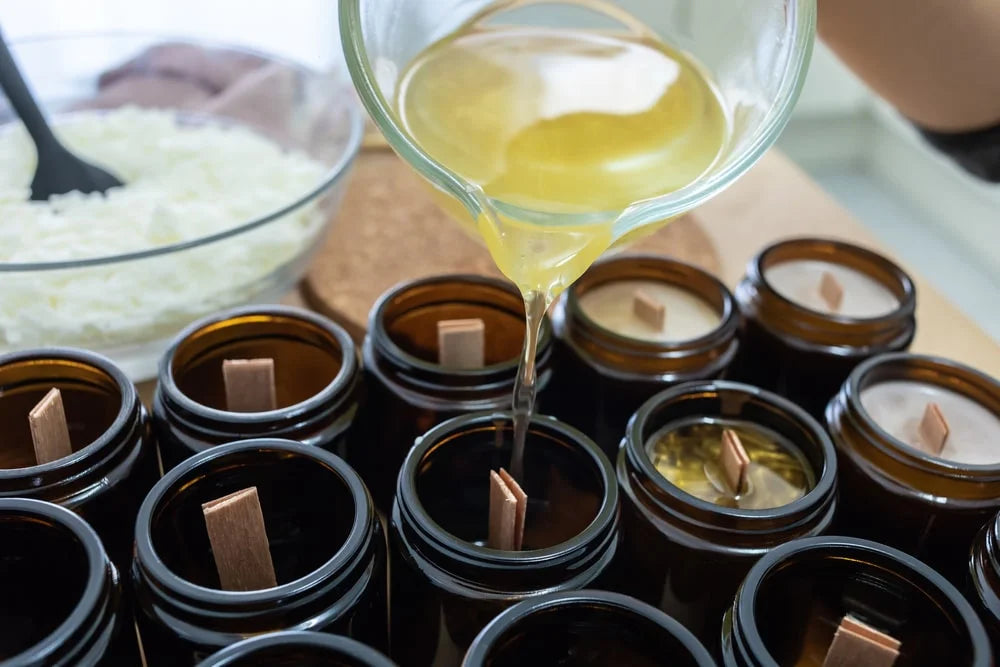
Now, this is a key point when you come to learn how to make scented candles. You need to pay attention to the recommendations of wick size for your molds or glasses. Whether you choose cotton or wooden wicks.
You cannot use just one sized wick for all. You need a selection if you have a variety of molds and glasses. Using the right diameter is crucial to right-sized flame and it burning evenly right to the bottom.
How many times have you used a scented candle in a glass and most of it is left around the rim of the candle glass? That is because the size of the wick was improperly matched to the size of the glass.
Ideally, you want it to burn to melt the surface of the wax across the diameter of the candle glass. This way it will burn evenly down. All that should be left is a couple of millimeters of wax at the bottom that was below the level of the wick holder.
Wick Holders Or Sustainers

I don’t have a great deal to share on this, other than it is tempting to skip them…. But if you do, it makes your life harder. Just buy them already!
You can buy them for cotton or wooden wicks they are slightly different so make sure you get the right type.
Also, make sure that you purchase a suitable fixative for your candle glasses or chosen surfaces. Generally, the same adhesive will work on glazed ceramic as glass. Bare terracotta and containers like coconut shells may need something suitable for more porous or curved surfaces.
Tools & Candle-Making Supplies To Help
I do find that when learning how to make scented candles people are surprised by just how little specialist kit you need.
Double Boiler
The alternative to a double boiler is a tin can sat in a saucepan of hot water. If you plan to make a few candles a year, stick to the tin can. If you want to make more or start a business then invest in a double boiler intended only for melting candle wax.
Once you melt wax in it, it is very hard to clean! I use mine for both candles and beauty products, so I often chuck some cosmetic butter and carrier oil in and swish it about to get the remainder of the wax off the pan. It turns into a lovely cream or salve, and it washes up much easier.
Don’t use the same pan you would use for food please, keep them separate.
Wick Holder Tool
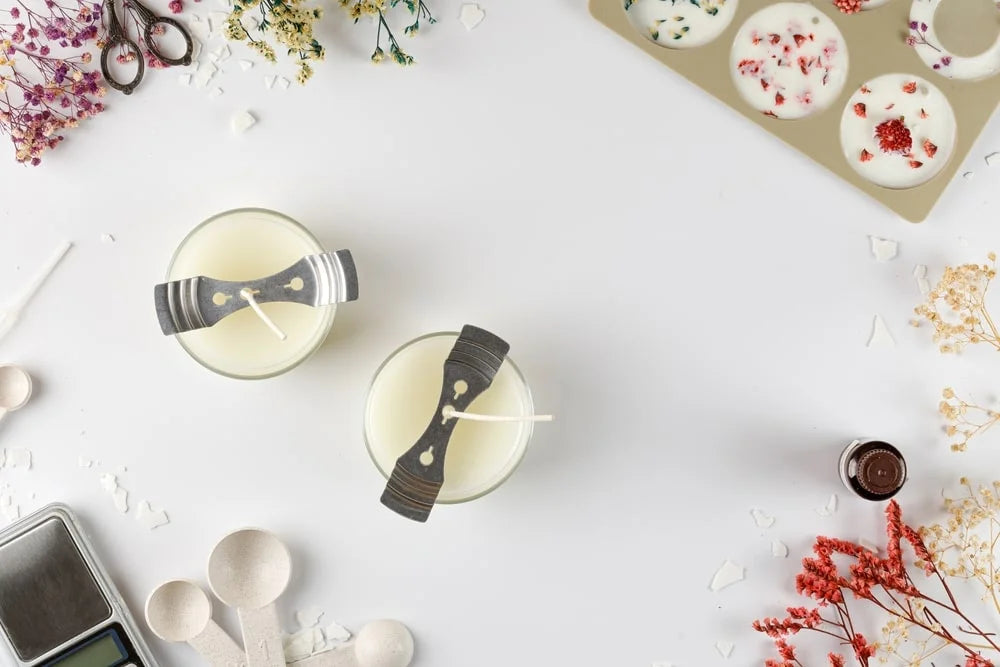
Often, you can buy a wick holder tool that sits atop your candle glass and keeps your wick perfectly straight. This helps to achieve that even burn and is a worthwhile investment if making more than a few.
You can only use it on one candle glass at a time. Therefore, if you plan to make ten candle glasses at a time, you will want ten wick holders too, if you plan to pour them all at once.
Candle-Making Kits
When you first learn how to make scented candles, don’t be too proud to buy a small kit to try it out first. It will have everything you need and you can familiarize yourself with the items, how they work, and how useful they are.
It can be a good exercise in working out whether it is for you or not before you go and spend more money than you need to.
Not sure if it is for you? Buy a small, cost-effective kit first!
How To Make Scented Candles - Essential Oils Vs Fragrance Oils?
We get asked all the time ‘how to make scented candles with essential oils’ and of course we have those that ask us ‘how to make scented candles without essential oils’. Both are entirely possible.
However, there are plenty of considerations and questions to consider when you first start out to learn how to make scented candles. One of those would be whether to use essential oils or fragrance oils to scent your candle.
We cannot pretend here; there are pros and cons for both essential oils and fragrance oils, let’s just take a look at some of them.
Essential Oils
My argument for using essential oils in your scented candles would be:
- Essential oils are 100% pure and derived from natural plant products.
- They have incredible therapeutic benefits and they can enhance your mood. It is well proven through scientific research that Lavender essential oil can calm you, and Sweet Orange can uplift you.
- Essential oils are naturally highly fragrant and when utilized and blended in the right way, they can be long-lasting in your scented candle.
- As the world shifts and becomes more eco-conscious, there is a much bigger demand for products using natural ingredients
- Naturally, it is the inclusion of these pure and natural ingredients that is becoming a big selling point.
Of course, there are some downsides to using essential oils:
- Unfortunately, despite being highly fragrant, you may not always get the same level of infusion into the air (also called the throw). This may need to be factored into your recipe and this is where your blending knowledge can come to the fore.
- Essential oils can be fragile and delicate little substances. Occasionally, some essential oils can degrade when exposed to higher burning temperatures. It is this action that contributes to it not having a great ‘throw.’ Some essential oils are better than others; this is where your experimentation and learning become key.
- We all know that essential oils can be expensive. There's no two ways about it, you will need a lot of oil to get a strong scent. Therefore, it stands to reason that if you aim to sell them, it forces your hand to price your scented candles at the higher end of the scale.
Fragrance Oils
My argument for using fragrance oils in your scented candles would be:
- Fragrance oils are specifically designed for use in candles and generally withstand higher heat and temperatures.
- They are designed to last a long time and for the longevity of the candles, though some are better than others at this.
- You can get extremely strong fragrances that make highly scented candles.
- They can be much more cost-effective, especially for those with hobby businesses.
- There are exciting ranges and selections from favorite perfume dupes, hotel collection dupes, and those that mimic the more expensive or endangered essential oils like Sandalwood and Rosewood.
Of course, there are some downsides to using Fragrance Oils:
- Fragrance oils that are formulated solely in top notes can be ethereal and not last as long as a more rounded scent profile. They get lost easily in soaps and candles but work well in diffusers.
- Fragrance oils rich in heady base notes, or Vanilla, can sometimes be overwhelming.
- While some fragrance oils are made from entirely naturally derived fragrances, many are synthetically derived and involve chemical processes.
- They have no therapeutic benefits at all.
I strongly encourage you to have a go and experiment with your favorite essential oils and
fragrance oils when you first learn how to make scented candles. You will learn so much from experimentation, even if you do make a few mistakes.
Work with both fragrance oil and essential oils for candle making and expand your knowledge base and recipe repertoire.
Perfume
Occasionally we get asked ‘how to make scented candles with perfume’ and this is not something we recommend. For one, you would need so much perfume it would be a ridiculously expensive exercise and a futile one.
The alcohol content in your perfumes is there to dilute it down and make it go further and this hinders its use in candles. You get very little ‘throw’ and any essential oils are degraded more easily by the heat because the alcohol burns them hotter and faster.
It has been known for the alcohol to separate from the wax and cause issues of separation between the wax and the oils. Spoiling your batch.
There are so many cons to this, we simply want to save you from any disappointment. Expensive disappointment at that! Find a perfume dupe fragrance oil instead and use that.
Choosing Between Essential Oils and Fragrance Oils - The Balance
Scented candles using essential oils are perfect for a therapeutic-themed candle for my small bathroom. It doesn’t have to fill a huge room with scent and I will get all the wonderful fragrant and mood-altering benefits of the essential oils
However, if I were making a scented candle for the front desk of a large reception in a spa or hotel, then I would need to strongly consider using fragrance oil for that better throw of fragrance. Of course, it would have absolutely no therapeutic benefits.
Now that you know what the pros and cons are, you can make an informed decision. Base it on what is best for you, the type of product you wish to create, your target market, and your budget.
Can I Mix Essential Oils and Fragrance Oils In A Scented Candle?
Yes, absolutely. Do it!
How To Make Scented Candles- Five Essential Oils
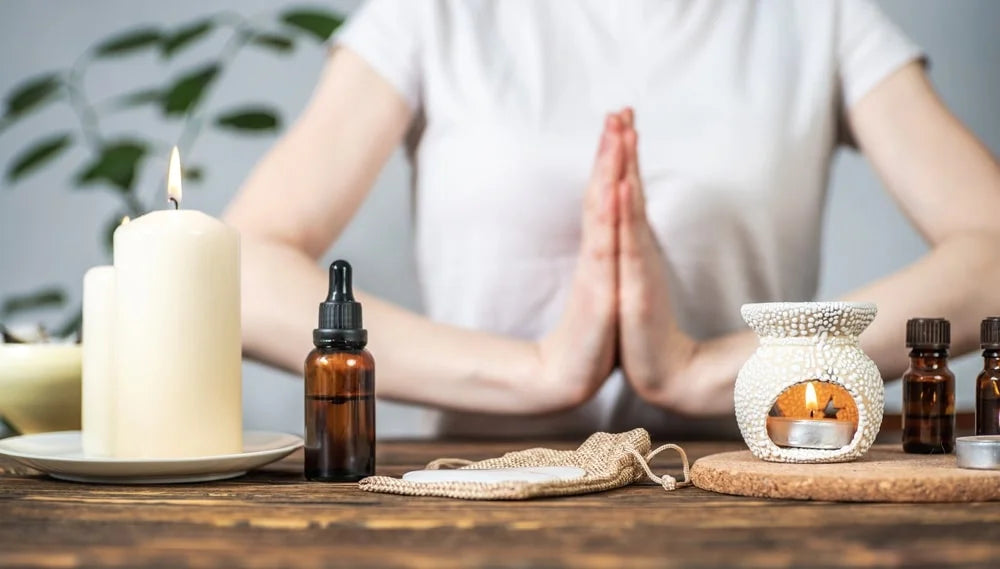
It can be a confusing time when you first start learning how to make scented candles. Especially when it comes to which essential oils to use.
I have chosen essential oils that have performed for me time and again and never seem to let me down.
Lavender (Lavandula angustifolia)
Lavender never lets us down, does it? It is so versatile to use in scented candles. Lending itself to those relaxing blends to encourage rest, and relaxation and decrease anxiety and stress.
We can blend it with the more stimulating essential oils like Rosemary and Thyme for something a bit more invigorating and it will lend that beautiful floral background to those green herbs.
I would always encourage you to start here because often, it can be quite cost-effective too.
Also read: What Mixes Well With Lavender Essential Oil?
Rose Geranium (Pelargonium asperum var roseum)
This is one of my favorites to use in wax of any kind because it anchors itself so readily and seems to withstand the high heat and throw well. Rose Geranium I find works extremely well in both Beeswax and Soy wax. I am not keen on the fragrance of it in Paraffin wax. But please, experiment with it for yourself.
It blends readily with Lavender and will also stand up to a Rose fragrance, giving you that glorious Rose scent with ALL the uplifting benefits of the Rose Geranium essential oil too.
Also read: Rose Geranium Blending
Cedarwood (Cedrus deodara)
This is another essential oil that never lets me down and adds its deep earthy scent to the base notes of the scented candle.
Create a beautifully serene atmosphere and blend it with Patchouli, enliven and stimulate it with Sweet Orange or Grapefruit essential oils.
Also read: Blending Ideas For Cedarwood
Clary Sage (Salvia sclarea)
Gorgeously green and fresh, bring the outside in with Clary Sage essential oil. Ramp up the green theme with Peppermint, Spearmint, or Eucalyptus.
Balance the top notes of Clary Sage with the deep base notes of Vetiver and heart notes of Marjoram for a green, grassy, and herbal scentsation.
Not everyone likes Clary Sage, so it can be a little polarizing, but it blends beautifully and delivers all of its wonderful therapeutic benefits too.
Also read: Blending With Clary Sage
Bergamot (Citrus bergamia)
Bright, fresh, breezy. The perfect Citrus note.
Strong, reliable, and has a whole host of incredible therapeutic benefits. It is widely used for uplifting people with anxiety and depression. It is a powerful mood booster and perfect for people feeling a little low.
It is an easy essential oil to blend with and is very forgiving. Load up on the Citrus theme with Lime, Grapefruit, and Sweet Orange for a Citrus burst like no other.
Entwine it with florals like Jasmine and Neroli. You can use these as fragrance oils for cost-effectiveness.
Also read: Bergamot Essential Oil Blends: 4 Seasons Of Bergamot
How To Make Scented Candles - Five Fragrance Oils
These are some of the most popular recommendations for those at the beginning of their journey learning how to make scented candles.
Vanilla or Citrus Odor Eliminator
One of the main reasons people learn how to make scented candles is because they want their home to smell attractive. Sometimes, that might even mean hiding or masking whiffs and pongs.
These Odor Eliminators are perfect for those times when you’ve just cooked fish, been dumped with the team’s dirty soccer kit or have been painting or varnishing during renovations.
We offer both Vanilla and Citrus Odor Eliminators. They are extremely popular and one I recommend for beginners.
NO. 1000 - Inspired By: My Way & The One Hotel
Perusing our Social Media comments, this is one of the fragrance oils from the Hotel Collection that people rave about the most. It gets great reviews from our candlemakers and our soap makers.
The scent profile is beautifully rounded with its blend of fragrance notes. From Lemon, through Cardamon, Cinnamon, Cedarwood, Sandalwood, and deepening through Leather, Vetiver, Iris, and Musk. It is Scentsational!
Customers comment on what a strong scent they get and what a great throw they can achieve with this fragrance oil. I have to agree.
Coco Chanel #5
Unsurprisingly, this is one of our most used perfume dupes. Chanel No. 5 sells about 10 million bottles across the globe annually! That is a lot of perfume admirers. Including myself. Who doesn’t like a dab of No. 5 behind their ears?
Commercially, our customers are reporting consistent feedback about their customers loving it. More importantly, having those repeat customers, coming back time and again, is just what you want. It is crucial when you are thinking about starting a scented candle hobby business.
Beautifully romantic with a start of glorious Rose, Lemon, Orange Blossom, Patchouli, and floral spice notes. Sensuously deepened with heady Woods and stunning Amber, then brought to a magnificent crescendo of fragrance with Vetiver.
It’s a bestseller for a reason, people LOVE it… and so do I!
Ocean Rain
One of the things you need to experience when you first start to learn how to make scented candles is how to achieve that freshness and sense of cleanliness that customers are trying to evoke.
It can be tricky to get the balance right with both essential oil blends and fragrance oils. However, Ocean Rain fragrance oil makes it a doddle with its crisp scent notes of Sea Salt, Orange, and Rose and it does this balancing job for you beautifully.
When people are looking for bright, breezy, and fresh, this should be at the top of your list, closely followed by Fresh Linen, Our Version Of Eucalyptus Spearmint By BBW, and Downy April Fresh.
We featured Ocean Rain as our Fragrance Oil Of The Week check it out for a range of ideas. It’s not just for candles you know!
Honeysuckle & Jasmine
One of the best things you can learn about when you set out to learn how to make scented candles is how to layer fragrances in the home. It will certainly be a cornerstone of a hobby business selling fragrance products like candles, diffusers, and wax melts.
Defining which fragrance oils will readily lend themselves to layering is key. We start the process by looking at the scent notes:
Scent Notes of Honeysuckle Jasmine
- Top: Neroli, Cassia
- Mid: Iris, Jasmine, Honeysuckle, Rose, Lily
- Bottom: Sandalwood
We have a glorious range of scent notes to build upon. We can add more florals like Rose and Jasmine to deepen the floral aspect with a matching diffuser.
You could offer wax melts loaded with Sandalwood and Cassia for a more sensuous effect.
The variations are almost endless and it’s a skill that I urge you to learn alongside your practical candle making.
Learn more about scent layering in these articles:
Basic Process To Make Scented Candles
We will give you a step-by-step guide to the basic scented candle-making process that you can use for any wax type.
You can build on the variations and recipes from here. We will give you some great recipe ideas next.
You Will Need:
- A double boiler purely to melt the wax (or an old saucepan and an empty tin can)
- Disposable stirrer or spoon.
- Candle wicks, of your choice (note they must be the right size for the mold or candle glass that you are using - follow the manufacturers' guide).
- Candlewick holders and suitable adhesive
- Candlewick centering tool (or a long pencil)
- Candle glasses or molds (Heat proof)
- Disposable covering like newspaper
Ingredients
One of our wonderful candle-making customers Justin Brown recommends using 1 fl oz of fragrance oil per pound of wax. I think that’s a perfect proportion for fragrance oils.
However, you may want a dash more for certain essential oils that lack the intensity of fragrance.
- 1lb (453 gms) of Wax pellets or flakes
- 1 fl oz (@30ml) Fragrance or Essential oil
Instructions:
Getting Ready
- Set up your workspace by covering your surface with a disposable covering, like the newspaper. Cleaning up spilled wax is no fun at all and you will be glad you did this!
- Before you begin, make sure you have everything you need to hand as you need to work quickly.
Melting The Wax
- Over low to medium heat, melt the wax using a double boiler. If you don’t have one, use an old (but clean and rust-free) tin can to hold your wax and fill a saucepan with water. You want it to come halfway up the tin can, containing your wax).
- If you feel the wax is taking more than a few minutes to melt, just turn the heat up a fraction; it should melt readily and easily.
- Give it a good stir with a disposable stirrer. Be sure to break up any clumps and help the melting process along a bit.
- While you're waiting for the wax to melt, securely anchor the wicks to the bottom of the candle glass or jar. Be sure to use an appropriate adhesive and one that will be unlikely to dislodge. Needless to say, do not use wax; it will melt when you add the molten wax.
- Align the wick to the center of the candle glass or mold, using the centering tool or a long pencil. Make sure that it is straight at this point, otherwise, it will not burn evenly. Take the time to get this right, because it will pay off later for you.
Adding The Fragrance
- For just a few minutes leave the wax to cool in the double boiler and then add in your chosen fragrance or essential oils and stir to combine thoroughly.
- When you leave the wax to cool a little it will help preserve the integrity of the fragrance, especially, the essential oils, as they can sometimes degrade in heat.
Pouring The Wax
- Carefully pour your wax into the candle glasses or molds, in a slow and steady stream.
- Do not overfill your candle glass, jar, or mold
- Also, if you are using a candle glass, try to avoid any slips and drips, as they can be hard to clean from the glass jar afterward.
- Set the candles aside for at least a couple of hours until they are set solid. If you have used a large mold, wait a while longer before demolding them.
Trim the Wick
- Make sure to trim the wick above the rim of the candle glass or jar; it can be trimmed to the correct size once fully set and cured within 24-36 hours.
Cleaning Up and Safe Disposal
- If you have any excess wax, don’t dispose of it yet. Wait to see how your candles are set, they may need a top-up.
- Be sure to dispose of any wax by pouring it into a disposable container. I often choose to use a muffin case. A small round of leftover wax is a really useful thing and can be used for many things, especially scented ones. Use leftovers for projects like wax melts and sachets.
- Whatever you do, do not pour down the drain; it will set in the pipes and block your drain.
Our Favorite Recipes
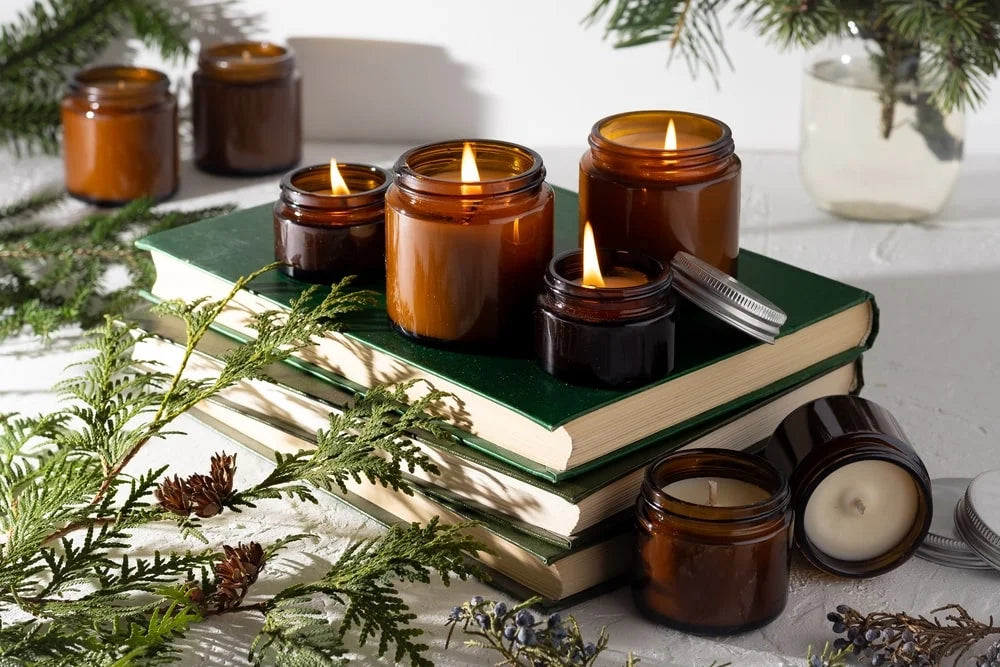
OK.. so now you know the basic principle of how to make scented candles and once you have gained some confidence why not try some of these exciting recipes that use VINEVIDA fragrance oil and essential oils.
We are not afraid of mixing essential oils and fragrance oils and neither should you be.
We try to advise you here of the best choices for wax types, wick types, and fragrance blends. Have fun experimenting with these, candle making is meant to be fun!
How To Make Scented Candles With Essential Oils
We recommend using this recipe with a cotton wick in an appropriate size for your candle glass or mold.
In 1lb (453 gms) of Beeswax add approximately 1 fl oz (@30ml) of essential oil. You may need a dash more of or less intensely fragranced essential oils.
Relaxing Scented Candle Blend
- 15 ml of Lavender Essential Oil (Lavandula angustifolia)
- 10 ml of Roman Chamomile Essential Oil (Anthemis nobilis L.)
- 5 ml of Vetiver Essential Oil (Vetiveria zizanoides)
Safety: Not for Topical Use
Sensuous Scented Candle Blend
- 15 ml of Ylang Ylang Essential Oil (Cananga odorata)
- 10 ml of Patchouli Essential Oil (Pogostemon cablin)
- 5 ml of Black Pepper Essential Oil (Piper Nigrum)
Safety: Not for Topical Use
Uplifting Scented Candle Blend
- 10 ml of Bergamot Essential Oil (Citrus bergamia)
- 10 ml of Sweet Orange Essential Oil (Citrus sinensis L)
- 10 ml of Grapefruit Essential Oil (Citrus paradisi)
Safety: Not for Topical Use
How To Make Scented Candles With Fragrance Oils
In 1lb (453 gms) of Soy wax add approximately 1 fl oz (@30ml) of Fragrance oil.
Sophisticated Scented Candle Blend
We recommend using this recipe with a crackling wooden wick in an appropriate size for your candle glass or mold.
- 25 ml of Baies By Diptyque Fragrance Oil
- 5 ml of Cedarwood and Amber Fragrance Oil
Refreshing Scented Candle Blend
We recommend using this recipe with a cotton wick in an appropriate size for your candle glass or mold.
- 25 ml of Ocean Rain Fragrance Oil
- 5 ml of Clean Cotton Fragrance Oil
Comforting Scented Candle Blend
We recommend using this recipe with a crackling wooden wick in an appropriate size for your candle glass or mold.
- 15 ml of Pumpkin Spice Fragrance Oil
- 15 ml of Our Version Of Leaves By BBW Fragrance Oil
How To Make Scented Candles With Perfume Dupes
In 1lb (453 gms) of Soy or Paraffin wax add approximately 1 fl oz (@30ml) of fragrance oil.
We recommend using this recipe with a cotton wick in an appropriate size for your candle glass or mold.
Chanel Inspired Scented Candle Blend
Gaultier Inspired Scented Candle Blend
Armani Inspired Scented Candle Blend
- 20 ml of Our Version Of Acqua Di Gio By Giorgio Armani Fragrance Oil
- 5 ml of Patchouli Fragrance Oil
- 5 ml of Ocean Rain Fragrance Oil
How To Make Scented Candles With Essential Oils and Fragrance Oils
In 1lb (453 gms) of Soy or Beeswax add approximately 1 fl oz (@30ml) of fragrance and essential oils.
We recommend using this recipe with a cotton wick in an appropriate size for your candle glass or mold.
Sex Bomb-Scented Candle Blend
- 15 ml of Our Version Of Bombshell By Victoria's Secret Fragrance Oil
- 5 ml of Our Version Of Love Spell By Victoria's Secret Fragrance Oil
- 5 ml of Ylang Ylang Essential Oil (Cananga odorata)
- 5 ml of Patchouli Essential Oil (Pogostemon cablin)
Safety: Not for Topical Use
Welcome Home Scented Candle Blend
- 10 ml of Citrus Odor Eliminator Fragrance Oil
- 10 ml of Honeysuckle & Jasmine Fragrance Oil
- 3 ml of Cedarwood Essential Oil (Cedrus deodara)
- 3 ml of Scotch Pine Essential Oil (Pinus sylvestris)
- 4 ml of Lemongrass Essential Oil (Cymbopogon flexuosus)
Safety: Not for Topical Use
WOW Me Scented Candle Blend
We recommend using this recipe with a crackling wooden wick in an appropriate size for your candle glass or mold.
- 20 ml of Our Version Of Baies By Diptyque Fragrance Oil
- 1 ml of Our Version Of Feu de Bois By Diptyque Fragrance Oil
- 5 ml of Rose Geranium Essential Oil (Pelargonium asperum var roseum)
- 1 ml of Palo Santo Essential Oil (Cymbopogon martinii var Motia)
- 3 ml of Pink Pepper Essential Oil (Schinus Molle)
Safety: Not for Topical Use
Safety Considerations
Now that you will be making all these incredible candles, you will want to be lighting them up left, right, and center.
Always remember to proceed with caution when lighting candles. Ensure they are on a fireproof candle plate and placed out of draughts and breezes.
Never leave burning candles unattended and always ensure they are out of reach of both pets and children too.
Don’t use them for too long at a time because it’s all too easy to go nose blind and not smell it anymore. The candle hasn’t stopped working, your brain just stopped processing the scent! Light them for an hour or so, then extinguish and relight after 30-60 minutes.
Have fun, but be sensible, please.
Final Words
I hope that you have enjoyed learning how to make scented candles and have enjoyed the journey with me.
You can now take paraffin wax, beeswax pellets, or soy wax flakes, mix them with your favorite essential oils and fragrance oils, and make your homemade candles. They will be so professional-looking looking no one would ever know they were DIY candles.
From popping them in mason jars, candle glasses, or molds you can very easily make your candles at home with just a few candle-making supplies.
Whether you are searching for how to make scented candles to sell or just to make a few for yourself, hopefully, you found what you need here.
Demystifying How to Make Scented Candles With Essential Oils
Regardless of whether you are looking for how to make scented candles without essential oils or with them. You can now weigh up which is the best choice for the candle you are making.
Being able to discern when to use essential oils fragrance oils…or even a combination of both is what will help set you apart from the crowd. Remember to learn that layering technique to expand your skill set and the products you combine to create a full-bodied experience for your customers or friends and family.
For those of you, who want to learn how to make scented candles with perfume, just don’t! Use fragrance oil dupes instead and don’t be afraid to mix them with essential oils to boost the scent profile in your favor.
Just Enjoy Yourself
It is important when learning a new skill to not get too anxious or stressed about the process. You are learning something new and will make mistakes, it is simply part of the process. After all, you would not get into a car, as a new learner, and expect to drive it perfectly the first time. Would you?
Enjoy exploring the ingredients, enjoy the gorgeous fragrances, enjoy the fruits of your labor, but more importantly enjoy the process of learning how to make scented candles. Enjoy!!


















